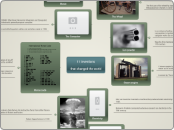FILIPINO 1
Autos = Self
Bios = Life
Graphy=Writing
An autobiography is the author's retelling of their life. This is written in first person and the author is the main character.
Major accomplishments
Add both your personal and professional accomplishments.
Professional
Personal
Additional info
LESSON 2: COMMUNICATION & RESEARCH IN FILIPINO LANGUAGE & CULTURE
HOMOGENOUS AND HETEROGENOUD LANGUAGES:
Heterogenous refers to dialectal variation depending on context and on those who speak it
Refers to words that have different styles but still maintain the same meaning like "slang" (Example:
Homogenous refers to the single characteristic and form of language (standard of language)
Refers to the similarity of words in spelling, although may have different meanings ( Example: Puno: Tree, Puno: No space)
BILINGUALISM AND MULTILINGUALISM
In multilingualism: One is capable of speaking up to 3-4 languages and is able to understand them regardless of the amount of knowledge they have pertaining to it.
Multilingualism is derived from "multi" meaning many and "linguistic" meaning language.
In Bilingualism: One is capable of using his/ her native language and also shift to borrowed languages that become their own over time
Bilingualism is derived from "bi" meaning 2 and "linguistic" meaning language
VERNACULAR
Example : Ilocano, Cebuano, Bikol
Mother tongue spoken by people (Philippines has 111 dialects)
WIKANG OPISYAL/ OFFICIAL LANGAUGE :
The official language of ones government
WIKANG PANTURO/ LANGUAGE OF INSTRUCTION :
Language used for formal education (Teaching and learning)
WIKANG PAMBANSA/ NATIONAL LANGUAGE:
Creates unity and development within the citizens of a country (For example: Filipino)
LIGGUWISTA/ LINGUISTS
Hemphill
To communicate efficiently, spoken symbols are customary and dynamic to further unite, interact and understand one another.
2)Sapiro
Focuses on conveying desires or feeling by the means of creating sounds
1) Gleason:
Language uses spoken sounds to communicate by those belonging in a culture
Scientists who study linguistics
LINGGUWISTIKA/ LINGUISTICS
Study that observes every aspect of language (grammar, vocabulary, etc.)
WIKA/ LANGUAGE:
Add the things you like and make you a happy person!
Use of sounds and symbols to communicate
LESSON 1.1: ORIGINS OF LANGUAGE
Add your vision for your future! You can choose to add your short term goal or long term goal!
6. THE GESTURAL THEORY
Critics argue that it falls short of accurately
explainingwhy, in most societies, speech eventually took the role of gestures.
Implies that before language evolved into spoken communication, it was merely a system of gestures.
5. THE YO-HE-HO THEORY
Critics claim it falls short in explaining how complicated syntax and semantics came to be.
Implies that language originated as a coordinating tool engaging in group activities and promoting social cohesiveness.
4. THE POOH-POOH THEORY
Critics of this take say that mere emotional outbursts are insufficient to serve as the foundation for a
complex language system.
Implies that the origin of language lies in spontaneous human exclamations and interjections caused by
pain, surprise, or other strong emotions.
3. THE TARARA-BOOM-DE-YE THEORY
Critics claim that it falls short in explaining how the syntactical and language semantic complexity.
Proponent: Not specified
implies that humorous, musical, and rhythmic expressions often in a social context—were the precursors of language.
2. THE DING-DONG THEORY
The harmony or disharmony of the sounds of nature served as the inspiration for words.
Implies that language changed over time in response to the resonances in the natural world.
1. THE BOW WOW THEORY
The origins of language were mimics of natural sounds.
Proponent: Max Müller
Implies that attempts to imitate were the source of language.
sounds of nature.
Work
Add the places you have worked. Additionally, you can mention what you learned from each of them.
Current job
Other jobs
First job
Education
Add the institutes where you got your degrees.
College
High School
Primary school
Childhood
What and who made you who you are today?
Influencing people
Memorable events
Growing up in
LESSON 1:ACCOUNTS ON THE ORIGINS OF LANGUAGE
Add information about your family. Usually, the mother's maiden name is written.
Additionally, you can add their age.
BIBLICAL ORIGIN OF LANGUAGE
Explains how language is exclusive to mankind and why it shares the unique aspects if language.
It does not describe the origin of language, but is seen to be a trait of God himself
THOMAS SEBOK & NOAM CHOMSKY
Are viewed as a modeling system that have appeared in the history of life which may have evolved from the previous animal system.
Both are the founding fathers of the following research fields: Biosemiotics & Biolinguistics
OTTO JESPERSENS LANGUAGE ORIGIN HYPOTHESIS
Is a Danish linguist who contributed to phonetics, linguistic theory and the History of English
MYTHOLOGICAL ORIGIN OF LANGUAGE
THE THREE MYTHS ABOUT ORIGIN OF LANGUAGE:
3. THE DEATH OF WURRURI
Languages became a product of eating different body parts
Derived from an aboriginal tribe in Southern Australia
2. THE HINDU WORLD TREE
Also known as the "world tree" or "knowledge tree" that supposedly grew to the heights of heaven had its branches chopped off and scattered all around the Earth
1. THE TOWER OF BABEL
Reason for several languages is due to language dispersion and confusion amongst population.
Found in the Hebrew Bible.
Represents the countless theories of the origin of Language
SCIENTIFIC ORIGIN OF LANGUAGE
Study of linguistics was applied to observe the meaning and function of language
HISTORICAL ORIGIN OF LANGUAGE
Language dates back to about 150,000 years ago although evidence only dates up to 6000 years.
Personal information
Add your personal information.
Other
Nationality
Place of birth
Age
Name









